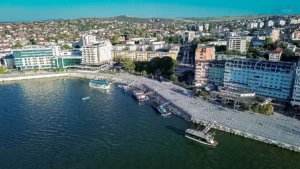
Little grebe

Description and how to observe Little grebe:
The Little grebe is the smallest species of corcodel in Europe, about 25-29 cm long and weighing 130-235 g. The feathers are predominantly brown, with a characteristic chestnut-coloured patch on the throat and a yellow stripe near the beak. In the Danube Delta, this species can most commonly be seen in still lakes, canals with abundant vegetation and areas of standing water. The easiest way to identify it is by its distinctive sounds, a repetitive trill, which becomes more intense during the breeding season.
What it feeds on Little grebe:
The diet of the Little grebe consists mainly of small fish, aquatic insects, larvae and crustaceans. It is an agile hunter, using its diving ability to capture prey underwater.
Threats:
Little grebes face multiple threats including habitat destruction, water pollution, uncontrolled tourism and nesting disturbance. Climate change is also affecting the availability of habitat and food resources.
Ecological role:
More information about Tachybaptus ruficollis:
The Little grebe is protected at European level by European Union legislation and is included in Annex I of the Birds Directive. Its observation and protection contribute to the conservation of biodiversity in the Danube Delta, one of the most important wetland ecosystems in the world.
Discover now the most beautiful places in the Danube Delta!
In the following pages, you will find detailed information about:
- Top tourist destinations: Traditional villages, nature reserves, tourist trails and much more.
- Activities and attractions: Everything you need to know about boating, fishing, bird watching, cycling and other activities.
- Accommodation and catering: Accommodation to suit all budgets and restaurants serving traditional cuisine.




